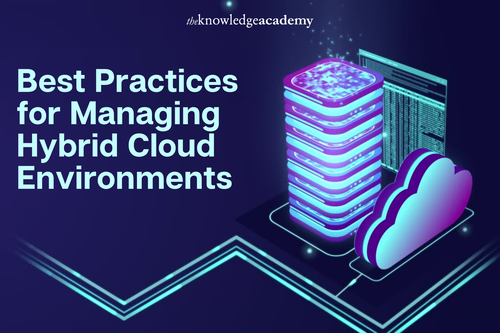Have you adopted a hybrid cloud strategy in your business? Managing these intricate ecosystems becomes increasingly important as companies move to hybrid cloud environments to balance the advantages of both private and public cloud infrastructures. Are you negotiating the subtleties of a hybrid cloud arrangement? Indeed, you are not alone.
This blog will explore best practices for managing hybrid cloud settings so your company can use this scalable and adaptable solution fully. These ideas will let you understand How Does Cloud Computing Work that simplify processes, improve security, and maximise performance, whether your role is business leader, cloud architect, or IT manager. Consider taking a Cloud Computing Course to further deepen your knowledge and skills in this critical area.
Table Of Contents
- Define Clear Objectives and Strategy
- Ensure Robust Security and Compliance
- Implement Unified Management Tools
- Optimise Workload Placementp
- Establish Strong Networking Connectivity
- Foster Collaboration and Training
- Leverage Automation and AI
- Conclusion
Define Clear Objectives and Strategy
Defining goals and a thorough plan is vital before delving into hybrid cloud administration. Think through the following queries:
- What are the primary goals of adopting a hybrid cloud environment?
- Which applications and workloads will live on the public rather than the private clouds?
- Between the two settings, how will data be moved and controlled?
Ensure Robust Security and Compliance
In every cloud system, security is the priority. Implement robust security policies and guarantee industry regulatory compliance in a hybrid configuration. Important practices include:
- Encryption: To guard private data, encrypt it in transit and at rest.
- Access Controls: Apply identity management and robust restrictions to limit illegal access.
- Compliance: Stay current with legal requirements and ensure that your hybrid cloud design meets PCI-DSS, GDPR, and HIPAA.
According to a 2023 survey by Flexera, 81% of enterprises reported having a multi-cloud strategy, and security remains a top challenge for 81% of respondents.
Implement Unified Management Tools
Dealing with a hybrid cloud means control over public and private cloud resources. Apply cohesive management tools to:
- Centralised Monitoring: Track performance, availability, and security across all cloud environments from one dashboard.
- Automation: Automate everyday tasks, including provisioning, scaling, and patching, to cut hand-offs and minimise mistakes.
- Cost Management: Track and maximise cloud use to stop budget overruns and raise cost-effectiveness.
Optimise Workload Placement
Maximising the performance and cost-effectiveness of your hybrid cloud depends on careful work placement. Take these elements into account:
- Latency: Place latency-sensitive apps either inside private data centres or near end-users.
- Scalability: Use public clouds for projects needing dynamic scaling.
- Compliance: Make sure compliant environments house workloads with strict compliance needs.
A Gartner report predicts that by 2025, 75% of enterprise-generated data will be created and processed outside a traditional centralized data center or cloud, up from 10% in 2022.
Establish Strong Networking Connectivity
Perfect data flow and communication across public and private clouds depend on dependable, high-performance networking. Essential procedures consist of:
- Direct Connect: Use dedicated connections such as AWS Direct Connect or Azure ExpressRoute to create private, low-latency interconnections between on-site and cloud settings.
- VPN: Apply safe VPNs for online encrypted communication.
- SD-WAN: Use software-defined wide area networks (SD-WAN) to effectively and flexibly control traffic.
Foster Collaboration and Training
Effective hybrid clouds require cooperation among development teams, security, and IT departments. Encourage group projects and lifelong learning by:
- Training Programmes: Offer programmes for cloud technologies and best practices training and certification.
- Cross-functional Teams: Create cross-functional teams to exchange knowledge and work on cloud projects.
- Feedback Loops: Create feedback loops to solve problems and improve cloud management techniques instantly.
A 2022 study by the Enterprise Strategy Group (ESG) found that organizations with a strong cloud training program are 2.5 times more likely to report high cloud adoption success.
Leverage Automation and AI
Hybrid cloud management’s efficiency and efficacy can be significantly improved by automation and artificial intelligence (AI). Consider the following:
- Automated Scaling: Automatically modify resources depending on demand using auto-scaling rules.
- AI-driven Insights: Leverage AI and machine learning to gain insights into performance, security, and cost optimisation.
- Infrastructure as Code (IaC): Apply IaC techniques to automatically provision and control cloud infrastructure.
Conclusion
Managing a hybrid cloud system requires a strategic strategy, solid security mechanisms, consistent management tools, and the best use of workload distribution, networking, cooperation, training, and automation. Following these best practices helps companies entirely use hybrid cloud infrastructures, attaining improved scalability, performance, and cost-efficiency. Consider The Knowledge Academy to confidently lead your organisation’s hybrid cloud management strategy. For more information visit: The Knowledge Academy.




